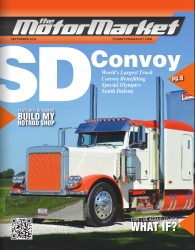More Issues
- August 2023
- September 2021
- August 2021
- July 2021
- June 2021
- May 2021
- April 2021
- March 2021
- February 2021
- January 2021
- December 2020
- November 2020
- October 2020
- September 2020
- August 2020
- July 2020
- May 2020
- April 2020
- March 2020
- February 2020
- January 2020
- December 2019
- November 2019
- October 2019
- September 2019
- August 2019
- July 2019
- June 2019
- May 2019
- April 2019
- March 2019
- February 2019
- January 2019
- December 2018
- November 2018
- October 2018
- September 2018
- August 2018
- July 2018
- June 2018
- May 2018
- April 2018
- March 2018
- February 2018
- January 2018
Slab Side
Car crafting can be summed up as the addition of new parts to an older vehicle in the name of better looks and/or performance. Non gearheads watch from the sidelines and ask why we don’t buy a new Camaro instead of year after year garage warfare trying to breathe life into an old shell. You and I know the reasons why; the new car has no soul, and anybody can buy a new Camaro, but it takes guts, creativity and gumption to create your own. Plus, there’s something magical about taking a part, be it a side mirror, transmission or set of wheels, from one vehicle and making it work in an application for which it was not designed. You’ve seen ‘50s vintage Chevy trucks with ‘90s stepside beds; think of this 1950 Chevrolet as a variation on that theme.
The world was set on its ear in 1955 when GM rolled out the Cameo, a pickup with integrated rear fenders. It was an extreme departure from the utilitarian truck boxes of the past and a huge leap forward in vehicle design. But what if the smooth-sided styling of the Cameo happened a few years earlier? Instead of picking up a fifties-ish Chevy SSR and calling it good, a group of magicians in Salt Lake City decided to find out. If there is any question regarding the abilities of the team at Kindig-It Designs, look no further than their ‘biggest’ accomplishment, the GM Futureliner restoration, and this doesn’t-actually-exist ’50 Chevy fleetside.
After weighing their options, Kindig-It Designs decided to start with a 1950 Suburban, slice off the top and a graft on the pickup cab. The handmade tailgate works like that of a Nomad, and in fact uses parts from a ’55 Nomad gate. The ‘shaved-off’ list is extensive, so I’ll give it to you it rapid-fire: bumpers, inner fenders, firewall, badges, drip rails, cowl vents, fuel filler, door handles. The doors are activated by Kindig-It’s signature smooth handles, while custom made running boards give the truck a sensuous shape. Audi Salsa Red and Chrysler Beige paint make a striking statement, while the two-tone split highlights the smooth bed sides.
Under the underside, you’ll find an Art Morrision chassis sporting rack and pinion steering with Wilwood dropped spindles up front, while a parallel four link with panhard bar keep track of a Strange engineering 9-inch in the aft-section. Brakes are spec’d at 14” and 12” with 6-piston calipers and commanded by a master cylinder located under the floor, all sourced from Wilwood. Keeping it all rolling are 19x8 and 20x10 Billet Specialties wheels outlined with Michelin Pilot Super Sports. The Tanks Inc. stainless fuel cell, 2 ½” exhaust with Flowmasters and the Tremec six speed transmission toil away in service to the GM LS3 crate engine. Off the shelf, this engine is rated at 430hp; as if quadrupling the truck’s original output wasn’t enough, a Magnuson supercharger was perched on top. These new blowers are so cool; check out the jackshaft running to the back of the unit, allowing for a front air inlet and super low profile boost.
The interior of a Kindig-It Designs-built vehicle never disappoints, and this truckurban has the best of the best from JS custom Interiors. Starting the journey with a pair of buckets from a 2009 Denali, Justin Stephens wrapped them, along with the hand built center console and door panels, with two tone leather. The dash was painted to perfectly match the upholstery, and all of it looks like melting ice cream. Dakota Digital printed custom faces for the VHX instruments, so even the gauges match the supple stitchwork. What you don’t see inside are the controls for the Vintage Air AC system, or the extensive Kicker sound system.
Hot rodders love adding creature comforts to old cars, but the real joy often comes from hiding them! The entire truck is full of thoughtful details, subtle tricks and plenty of talent; we’ve come to expect nothing less from Kindig-It Designs. While this truck goes way beyond slapping a 1992 bed on a 1950 pickup, and may be out of your range in terms of price and execution, let it be an inspiration for you and your project vehicle, and don’t be afraid to ask “what if?”







